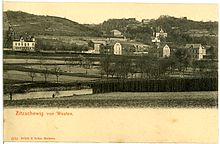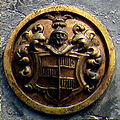Villa gratitude
The Villa Dankbarkeit is located at Mittleren Bergstrasse 42 in the Zitzschewig district of the Saxon city of Radebeul , within the historical vineyard area Radebeul below the Zechstein , directly to the east of the Krapenburg mansion . The house was the main house of the former Langenberg winery , whose triangular vineyard area, about one hectare in size, extends north-east of it up the mountain.
description
The lying on a corner to Lange Bergweg House with slightly L-shaped ground plan is together with western cultivation, the enclosure and the door system under conservation . According to the monument topography , the main building, which is used as a tenement house , is aligned lengthways directly on the street line of Mittlere Bergstrasse. The building, erected on a high quarry stone base, is nine to three evenly arranged window axes. On top there is a gently sloping gable roof that runs around the corner .
In the side view there is a central wrought-iron balcony on the upper floor facing east . In the main view there is an entrance door in the basement, in the third axis from the right. Above this part of the building, designed as a simple rectangular portal, there are two inscription panels. On the upper one, fastened with heraldic buttons, it says “Monument of gratitude. 1790 ”, on the lower one“ Rebuilt in 1879 ”. The buttons probably show the coat of arms of the Saxon-Meissen family Ponickau .
The facades are plastered, with joints on the mezzanine floor. There are cornices made of sandstone between the floors . The mezzanine floor windows are framed by sandstone walls and protected by horizontal roofing ; the upper floor windows alternate with triangular gable roofs.
To the left of the main building is a lower commercial extension from the 18th century, the plastered quarry stone façade of which is protected by a steep, tile-covered gable roof. On the side of this building is the gate from around 1905 with a wrought-iron, curved gate with the initials WL for Weingut Langenberg .
history


The Langenberg is a vineyard name documented as early as the 15th century, similar in age to the northwestern Kynast .
The vineyard estate described here was first mentioned as a winegrower's house with a vineyard behind it in 1709. Structural changes and extensions are documented for the year 1790. The plaque with the inscription “Monument of Gratitude. 1790 ".
In 1821 the vineyard belonged to the former mayor Dröher from Pulsnitz .
In the Meißner Netherlands from 1853, Lieutenant Fischer describes the mountain "with a small residential building" next to the Krappen ( Krappenberg ) as owned by the Buchdrucker Hofmann, and the plaque with the inscription "Monument of Gratitude" is also mentioned.
In 1872 at the latest, the winery was owned by the court pharmacist Ludwig Neubert from Leipzig , who in 1862 had built the Talutanlage on the neighboring Krapenberg for the weather-protected cultivation of table grapes and cold-sensitive fruit varieties . The main house with the fire register number 116 from Zitzschewig burned down in 1878/79, was rebuilt by Neubert in its current cubage as a new building and dated with the inscription to 1879.
In 1896, Professor Richert Schoepfer and his wife Paula set up a guest house for stately guests in the main house and named the house Villa Gratitude . Many international guests, for example from England, Scotland, Canada, Courland, Switzerland and Italy, have been regular guests for years and signed up in the guest book that has been preserved until 1907. Upon request, the host gave his guests singing lessons .
From 1908 the property was owned by the businessman Paul Vetterlein, who was succeeded by the businessman Ingurd Zuleger from 1912 to 1921. Then around 1922/23 the doctor Dr. med. Lippert also started his practice as a Zitzschewiger country doctor in his residence, who also treated Naundorf and Lindenau residents until 1932 . Lippert's widow was registered as a resident until 1944.
During the post-war period, the dentist Dr. Wise the municipal hand that occupied the house as a tenement house with residents. The former vineyards facing northeast were used by a commercial gardener.
After 1990 the property was given to the heirs of Dr. Lippert, who sold it to the current owners. Of these, the buildings were repaired taking into account monument conservation issues.
Villa Gratitude: Heraldic buttons for fastening the inscription plaque, probably 1790
( Herald's image : divided three times by white and red and split once)Compare: Coat of arms of those of Ponickau
(split and fourfold alternately divided by silver and red. On the helmet with red and white blankets a golden double goblet with three green parakeet feathers)
literature
- Volker Helas (arrangement): City of Radebeul . Ed .: State Office for Monument Preservation Saxony, Large District Town Radebeul (= Monument Topography Federal Republic of Germany . Monuments in Saxony ). SAX-Verlag, Beucha 2007, ISBN 978-3-86729-004-3 .
- Reiner Roßberg: "Villa Gratitude" . In: Radebeuler Monatshefte eV (Ed.): Preview & Review; Monthly magazine for Radebeul and the surrounding area . March 2012, p. 24 f .
Web links
- Photos from 1998 at the Deutsche Fotothek , accessed on May 14, 2012.
- Coat of arms of those of Ponickau (bottom left) in Johann Siebmacher's book of arms , accessed on May 14, 2012.
Individual evidence
- ↑ Reiner Roßberg: "Villa Gratitude" . In: Radebeuler Monatshefte eV (Ed.): Preview & Review; Monthly magazine for Radebeul and the surrounding area . March 2012, p. 24 f .
- ↑ Volker Helas (arrangement): City of Radebeul . Ed .: State Office for Monument Preservation Saxony, Large District Town Radebeul (= Monument Topography Federal Republic of Germany . Monuments in Saxony ). SAX-Verlag, Beucha 2007, ISBN 978-3-86729-004-3 , p. 218 as well as enclosed map .
- ^ Large district town of Radebeul (ed.): Directory of the cultural monuments of the town of Radebeul . Radebeul May 24, 2012, p. 27 (Last list of monuments published by the city of Radebeul. The Lower Monument Protection Authority, which has been located in the Meißen district since 2012, has not yet published a list of monuments for Radebeul.).
- ^ Frank Andert (Red.): Radebeul City Lexicon . Historical manual for the Loessnitz . Published by the Radebeul City Archives. 2nd, slightly changed edition. City archive, Radebeul 2006, ISBN 3-938460-05-9 , p. 244 .
- ^ Adolf Schruth; Manfred Richter (edit.): Chronicle: The Prokuraturamts- und Syndikatsdorf Zitzschewig . Radebeul 2010, p. 31 (first edition: 1934, online version (pdf; 671 kB) ).
- ^ Karl Julius Hofmann: The Meissen Netherlands in its natural beauties and peculiarities or Saxon Italy in the Meissen and Dresden areas with their localities. A folk book for nature and patriot friends presented topographically, historically and poetically . Louis Mosche, Meißen 1853, p. 692. ( online version )
Coordinates: 51 ° 7 ′ 16.3 " N , 13 ° 36 ′ 18.2" E









